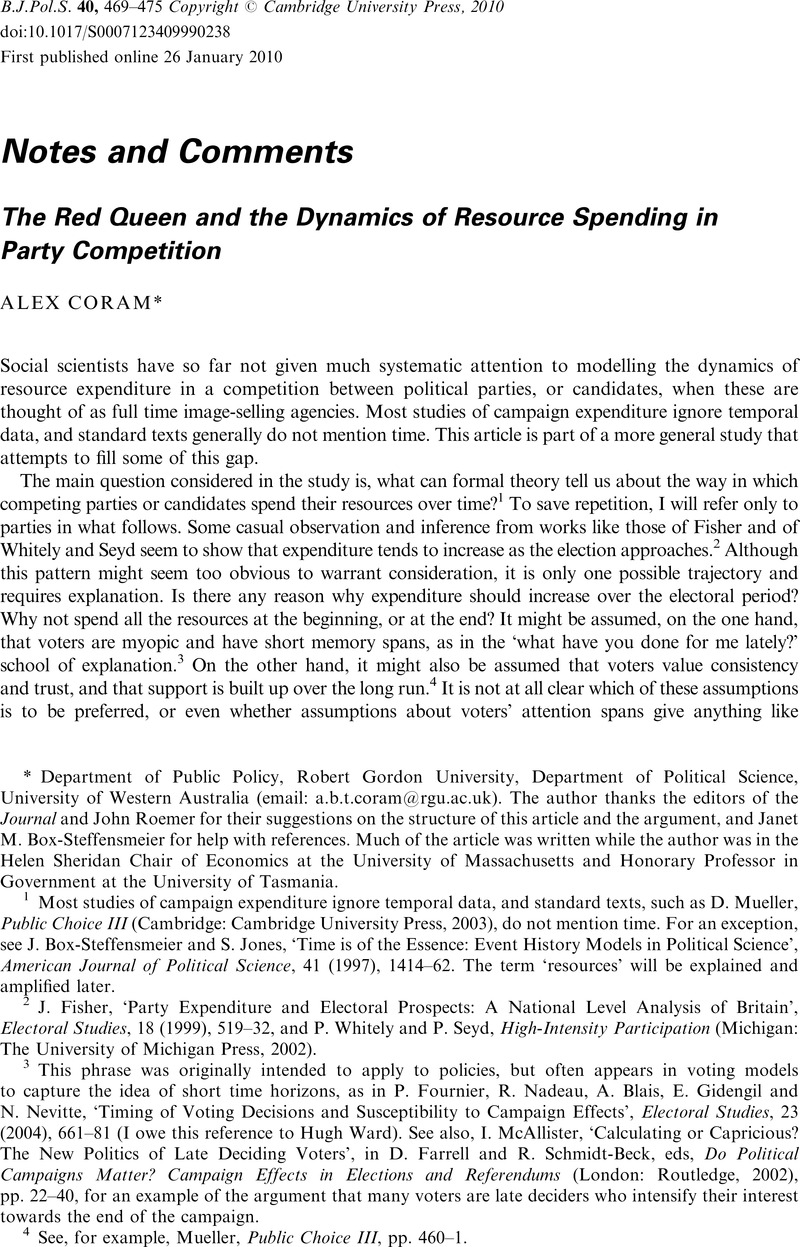Article contents
The Red Queen and the Dynamics of Resource Spending in Party Competition
Published online by Cambridge University Press: 26 January 2010
Abstract

Information
- Type
- Notes and Comments
- Information
- Copyright
- Copyright © Cambridge University Press 2010
References
1 Most studies of campaign expenditure ignore temporal data, and standard texts, such as Mueller, D., Public Choice III (Cambridge: Cambridge University Press, 2003)CrossRefGoogle Scholar, do not mention time. For an exception, see Box-Steffensmeier, J. and Jones, S., ‘Time is of the Essence: Event History Models in Political Science’, American Journal of Political Science, 41 (1997), 1414–1462CrossRefGoogle Scholar. The term ‘resources’ will be explained and amplified later.
2 Fisher, J., ‘Party Expenditure and Electoral Prospects: A National Level Analysis of Britain’, Electoral Studies, 18 (1999), 519–532CrossRefGoogle Scholar, and Whitely, P. and Seyd, P., High-Intensity Participation (Michigan: The University of Michigan Press, 2002)CrossRefGoogle Scholar.
3 This phrase was originally intended to apply to policies, but often appears in voting models to capture the idea of short time horizons, as in Fournier, P., Nadeau, R., Blais, A., Gidengil, E. and Nevitte, N., ‘Timing of Voting Decisions and Susceptibility to Campaign Effects’, Electoral Studies, 23 (2004), 661–681CrossRefGoogle Scholar (I owe this reference to Hugh Ward). See also, McAllister, I., ‘Calculating or Capricious? The New Politics of Late Deciding Voters’, in D. Farrell and R. Schmidt-Beck, eds, Do Political Campaigns Matter? Campaign Effects in Elections and Referendums (London: Routledge, 2002), pp. 22–40CrossRefGoogle Scholar, for an example of the argument that many voters are late deciders who intensify their interest towards the end of the campaign.
4 See, for example, Mueller, , Public Choice III, pp. 460–461.Google Scholar
5 A complete mathematical exposition and additional results are available in Coram, A., ‘The Dynamics of Resource Spending in a Competition Between Political Parties: General Notes on the Red Queen Effect’, University of Massachussets Amherst: Department of Economics Working Papers, 01 (2008)Google Scholar (http://www.umass.edu/economics/publications/papers00.html).
6 See Caroll, Lewis, Alice’s Adventures in Wonderland (New York: The New American Library, 1960).Google Scholar
7 See Whitely, , High-Intensity Participation, pp. 208–209Google Scholar, for a discussion of the importance of the activities of members and the role of voluntary activity as substitutes for other forms of campaign expenditure.
8 This assumption combines elements of the Michigan model, where party identification is largely fixed, and the literature which claims that support increases with campaign effort, for example Fournier, , Nadeau, , Blais, , Gidengil, and Nevitte, , ‘Timing of Voting Decisions and Susceptibility to Campaign Effects’Google Scholar.
9 These are analysed in Coram, , ‘The Dynamics of Resource Spending in a Competition Between Political Parties’.Google Scholar
10 John Roemer suggested using this example, and also went to the trouble of verifying results by solving the discrete problem for the two-player open-loop game.
11 The equation for the dynamics could easily be extended to take into account things like a natural rate of growth in support for one of the parties.
12 Coram, , ‘The Dynamics of Resource Spending in a Competition Between Political Parties’Google Scholar. The solution for other games under more general conditions is given in this work.
13 Not precisely because of the ![]() term.
term.
14 See Coram, , ‘The Dynamics of Resource Spending in a Competition Between Political Parties’, Appendix 2.Google Scholar
- 1
- Cited by

